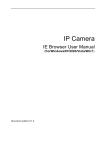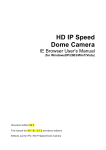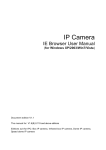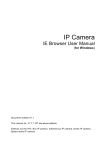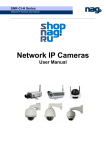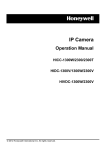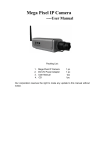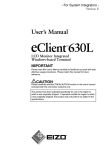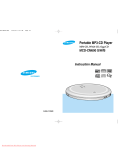Download IE Browser User's Manual V4.3-IP camera
Transcript
IP Camera IE Browser User'sManual (forWindowsXP/2003/Win7/Vista) Document edition:V4.3 The manual for: V2.3.1.2 and above editions Editions suit for IPC: Box IP camera, Infrared box IP camera, Dome IP camera, IP Camera IE Browser User’s Manual Preface Thank you for using our IP camera products. This series of products are all-in-one IP cameras designed for network video surveillance, including box IP camera, infrared box IP camera, dome IP camera, speed dome IP camera, etc. The products adopt high performance and powerful single SOC chip media processor to integrate audio and video capture, compression and transmission. Standard H.264 Main Profile coding algorithm ensures clearer and smoother video transmission effect. Built-in Web Server allows users to easily perform real-time monitoring and remote control over front-end cameras via IE browser. This series of IP cameras is suitable for small and medium-sized enterprises, families, and other environments that require remote network video transmission and monitoring. It is easy to install and operate. 2/68 IP Camera IE Browser User’s Manual Statement: Contents in this manual may be different from the edition that you are using. Should any unsolved problem occur given that the product is used according to this manual, please contact our technical support department or your product suppliers. The content of this manual may be updated at irregular intervals without prior notice. Readship: This manual is suitable for engineers as follow: System planning person Support and maintenance person Administrator User Notes: “IP Camera” mentioned in this manual refers to network camera, including box camera, dome IP camera, infrared box IP camera, speed dome IP camera,ect. Click: Press the left mouse button once. Double-click: Press the left mouse button twice. “[ ]”:Window name, menu name and datasheet. 3/68 IP IP Camera IE Browser User’s Manual Modify record: : Recording the corresponding update, the latest document include all of the content in previous editions. Modify date Edition Explanation According to the write standards 2010-12-1 of our company, typesetting the V4.0 document again. 2011-3-11 V4.1 2011-9-28 V4.2 2012-3-1 V4.3 modify the user manual. Update version, modify the user manual. Update version, modify the user manual. 4/68 IP Camera IE Browser User’s Manual Table of Contents 1 Download and install ActiveX......................................................................................................................... 6 2 Login .................................................................................................................................................................. 7 3 Live Preview ..................................................................................................................................................... 7 4 Record Playback.............................................................................................................................................. 9 5 Set System Parameters................................................................................................................................ 12 5.1 Local config ........................................................................................................................................... 12 5.2 Remote config ....................................................................................................................................... 13 5.2.1 Audio Setting............................................................................................................................ 13 5.2.2 Video Settings ......................................................................................................................... 13 5.2.2.1 Text Overlay .................................................................................................................. 13 5.2.2.2 Video Coding ................................................................................................................ 14 5.2.2.3 Video Mask ................................................................................................................... 17 5.2.2.4 Video Parameter .......................................................................................................... 17 5.2.2.5 Picture Parameter ........................................................................................................ 26 5.2.3 Network Settings ..................................................................................................................... 27 5.2.3.1 Basic Setting................................................................................................................. 27 5.2.3.2 LAN Setting................................................................................................................... 27 5.2.3.3 Wireless Setting ........................................................................................................... 28 5.2.3.4 PPPOE Setting............................................................................................................. 31 5.2.3.5 3G setting...................................................................................................................... 32 5.2.3.6 UPNP setting ................................................................................................................ 34 5.2.3.7 Email setting ................................................................................................................. 35 5.2.3.8 FTP setting ................................................................................................................... 36 5.2.3.9 DDNS setting................................................................................................................ 37 5.2.3.10 VPN setting................................................................................................................. 38 5.2.3.11 RTSP setting............................................................................................................... 38 5.2.3.12 Public IP noticed by email ........................................................................................ 40 5.2.3.13 Connect setting .......................................................................................................... 40 5.2.3.14 Mobile Setting ............................................................................................................ 40 5.2.4 Storage Settings ...................................................................................................................... 41 5.2.4.1 Device Setting .............................................................................................................. 41 5.2.4.2 Record Setting ............................................................................................................. 43 5.2.4.3 Snap Setting ................................................................................................................. 44 5.2.5 Alarm Settings ......................................................................................................................... 45 5.2.5.1 Motion detection........................................................................................................... 45 5.2.5.2 Sensor Setting.............................................................................................................. 46 5.2.5.3 Failure Setting .............................................................................................................. 48 5.2.5.4 Wireless Detection Setting ......................................................................................... 49 5.2.6 COM Setting ............................................................................................................................ 50 5.2.7 System Setting ........................................................................................................................ 51 5.2.7.1 System Info ................................................................................................................... 51 5.2.7.2 System Time ................................................................................................................. 51 5.2.7.3 User Manage ................................................................................................................ 52 5.2.7.4 Upgrade ........................................................................................................................ 53 5.2.7.5 PTZ Upgrade ................................................................................................................ 54 5.2.7.6 Restore .......................................................................................................................... 54 5.2.7.7 Reboot ........................................................................................................................... 54 Appendix 1 Network Interface of IP Camera ................................................................................................ 56 Appendix 2 Default Network Parameters ...................................................................................................... 56 Appendix 3 Apply for DDNS domain name service ..................................................................................... 57 Appendix 4 Visit IP camera under different network environments........................................................... 59 Appendix 5 FAQs .............................................................................................................................................. 66 5/68 IP Camera User’s Manual 1 Download and install ActiveX You need to install ActiveX Control when you visit IP camera for the first time through IE browser. ActiveX installing method: Download installation Input the IP address of IP camera in Internet Explore to enter into login page(see Figure 1), Click [File] to download the ActiveX: Figure 1 File download dialogue box pops up, click [Run] or [Save] to download ActiveX, after download it , double-click the downloaded file “xdview.exe” to install it. After installation completes, a message “Register OCX success!” will appear(see Figure 2 ). If the IE was opened ,there will pop up a dialogue box (see Figure 3),click [ok] then all of the opened IE will be closed. Figure 2 Figure 3 6/68 IP Camera User’s Manual 2 Login Reopen Internet Explorer after ActiveX installation completes, input IP address of the IP camera to turn to login page, enter username (default setting is admin) and password (default setting is admin), click login to enter into main interface(see Figure 4): Figure 4 3 Live Preview See Figure 5 for the interface of “Live Preview”: Figure 5 In the Liveview interface, users can do operations like Snapping, Recording, Playback, Call, Listen, Clear Alarm, Log Search, Local Zoom of Image, Full-screen Viewing, PTZ and 7/68 IP Camera User’s Manual Lens Control. [Snap]: click “Snap”, snap the current image and save it in .JPG format automatically to the storage directory of snapped images. [Record]: Manual image recording, automatically record current images and save them in .264 format to the storage directory of recorded images after the recording function turned on. Displayed status after recording starts: [Playback]: Click “Playback”, the playback page will pop up for searching and playback of recorded files or snapped pictures. [Call]: After turn on the audio talkback switch, the talkback between PC and IP camera can be performed given that audio talkback device is installed to the IP camera. The displayed status after audio turns on: [Listen]: After switch on the monitoring switch, PC can monitor the sound at the device end. The displayed status after monitoring starts : [Alarm]: When there is an alarm, double-click [Alarm] to cancel the alarm manually. [Log]: Allow users to search for operations and alarm log. The maximum capacity is 512 entries of message, when the number of entries exceeds 512, system will delete records of the earliest date automatically. [Zoom In]: This feature allows the manual drag and drop of video display area to realize partial zoom in. [Full Screen]: Display images in full-screen, right click to exit full screen mode. [PTZ Control]: Allows four-directional rotation, automatic adjustment of PTZ rotation speed(see Figure 6). [Lens Control]: Allows PTZ operations like Zoom, Focus, Aperture, Light, Clip, Preset set, and Preset Call(see Figure 7). Figure 6 Figure 7 8/68 IP Camera User’s Manual 4 Record Playback Click enter into video playback page (see Figure 8). Figure 8 Users can search for recorded image files or snapped pictures in local PC or storage device according to date. [Date]: Users can select certain date to perform recorded image file or snapped picture searching, click “date” button ,data selection page will pop up(see Figure 9): Click Click Click Click “《”icon to turn to previous year “ 》”icon to turn to next year “〈 ”icon to turn to previous month “ 〉”icon to turn to next month Figure 9 [PC]: Users can select certain date to perform recorded image file or snapped picture (stored 9/68 IP Camera User’s Manual in local PC) searching. [SD Card]: Users can select certain date to perform recorded image file or snapped picture (stored in device SD card) searching. [File List]: Shows the recorded image files or snapped pictures searched in the File List. The way to search for recorded image files or snapped pictures of a specific period(see Figure 10): Select to search for record files or snapped pictures in PC or device SD card The record file list searched is displayed on the left The picture list searched is displayed on the right The left side stands for hour, each grid means one hour The right side stands for minute, each grid means 2 minutes Yellow indicates the selected search period Blue indicates there are files and pictures searched of the selected period Display the files and pictures searched of the selected period Figure 10 [Play]: Choose the recorded image or snapped picture in file list, right click the file or picture or click “play” button to play. The contents will be displayed in the right window, users can view the playing information and control the process(see Figure 11): 10/68 IP Camera User’s Manual Figure 11 [Download]: Select the recorded files or snapped pictures searched from SD card in the file list, click “download” button to download the files to PC. [Download information]: Users can view the information downloaded after clicking “Download”(see Figure 12): Figure 12 Click [Pause] to pause download manually,click [Start] to continue to download the unfinished files,click [Delete] to delete the downloaded files,click [Close] to close the download information interface.If you close the Download Information window and click ,you can continue to view the information about download. 11/68 IP Camera User’s Manual 5 Set System Parameters 5.1 Local config See Figure 13 for the interface of “Local config”: Figure 13 [PC live view parameter setting] Code stream: set video stream for PC live preview, preferred stream and alternate stream are selectable. The parameters of preferred and alternate stream can be set up in [Video Settings]. Preview mode: users can choose Real time priority or Fluency priority mode according to their needs. Reset Mosaic: select this option to make image quality better, but CPU usage rate will be higher at the same time. [PC storage Parameter] Record file packing time: set packing time of record files for local PC when it is recording. Record file path: set the storage directory for local records and snapped files, the default path is C:\XDNVS. 12/68 IP Camera User’s Manual After you set these parameters, please click to make them valid. 5.2 Remote config 5.2.1 Audio Setting See Figure 14 for the interface of “Audio Setting”. Figure 14 [Enable audio]: turn on or turn off the audio of IP camera, When there is no need for audio, close audio input to save DSP resource and network resource. Audio is disabled by default. [Input type]:You can choose MIC or Line In input. [Type]:Support three types of audio compressed format:G.726,G.711A,G.711U,AAC. [Sampling]:Support audio sample rates of 8k ,16k and 32k. When you select AAC format, sample rate is fixed at 32K [Input Volume]:Adjust the device’s input volume to control the volume of Listen. [Output Volume]:Adjust the device’s output volume to control the volume of Call. After you set these parameters, please click to make them valid. 5.2.2 Video Settings 5.2.2.1 Text Overlay See Figure 15 for the interface of “Text Overlay ”: 13/68 IP Camera User’s Manual Figure 15 [Title]: the name of video channel, displayed at the bottom left of image(movable), maximum characters allowed: 32. [Color]:You can choose different colors for the text. [OSD]: Display or not to display Title, Date, Time, Week, Date Format and Frame/Bitrate of channels. [Position]: Can adjust the display position of video title and Date,Time,Week. After you set these parameters, please click to make them valid. 5.2.2.2 Video Coding See Figure 16 for the interface of “Video Coding”: Figure 16 14/68 IP Camera User’s Manual [Coding]: H.264 and MJPEG. [Image]: set definition of images. HD CMOS(-MPC) support: Preferred Stream:1600*1200/1280*960/1280*720; Alternate Stream:640*480/320*240/160*112; HD CCD(-MPS) support: Preferred Stream:1280*960/1280*720; Alternate Stream:640*480/320*240/160*112; Low light(-D),WDRD(-WDRD)support: Preferred Stream:1280*720; Alternate Stream:640*480/320*240/160*112; 2.0M,Low light(-TD)support: Preferred Stream:1920*1080/1280*960/1280*720; Alternate Stream 640*480/320*240/160*112; CMOS support: Preferred Stream:640*480/320*240/160*112; Alternate Stream:640*480/320*240/160*112; CCD support: PAL mode---D1(704*576)/Half-D1(704*288)/CIF(352*288)/QCIF(176*144) NTSC mode---D1(704*480)/Half-D1(704*240)/CIF(352*240)/QCIF(176*120) [Quality]:You can choose the right quality according to your need: Fine, Normal, Basic,and the parameters can also be user-defined by choosing [advanced]. [I frame interval]: Adjustable between 1~200(Preferred Stream), 1~120(Alternate Stream).Smaller I frame interval means higher image bitrate and better image quality. It is recommended to set the I frame interval as above 25. [Frame rate]: Set encoding frame rate per second. Under poor network condition, frame rate can be reduced to control encoding bitrate to make motion images flow more smoothly. [Rate control]: CBR and VBR are optional. CBR adopts constant encoding bitrate, VBR adopts variable encoding bitrate. [Bitrate]:The range of preferred and alternate stream is 30~16384Kbps.Higher bitrate setting can generate better image quality, but it occupies more bandwidth, please adjust the setting 15/68 IP Camera User’s Manual according to your actual bandwidth. Under CBR setting, [Bitrate] is the constant bitrate of encoding. Under VBR setting, [Bitrate] is the variable bitrate of encoding. [Quality]: Under CBR setting: set the bitrate range via “Image Quality”, 1 means it is controlled by the software, 2~6 means corresponding bitrate range is ±10%~±50% Under VBR setting: set image quality via “Image Quality”, smaller value of image quality means better quality and higher bitrate, but the bitrate will not exceed its set value. [LAN default value]: HD camera Preferred Stream: H.264 Coding: I frame interval: 75, frame rate: 25, bitrate: VBR, 720P: 4096 kbps, 1080P:8192kbps .image quality:2; MJPGE Coding: I frame interval: 75, frame rate: 25, bitrate: VBR, 720P: 9216 kbps, 1080P:10240kbps .image quality:2; Alternate Stream: H.264 Coding: I frame interval: 50, frame rate: 25, bitrate: VBR: 512 kbps,.image quality:4; MJPGE Coding: I frame interval: 50, frame rate: 25, bitrate: VBR: 4096 kbps.image quality:4; SD camera Preferred Stream: H.264 Coding: I frame interval: 50, frame rate: 25, bitrate: VBR: 2048 kbps,.image quality:2; MJPGE Coding: I frame interval: 50, frame rate: 25, bitrate: VBR: 4096 kbps,.image quality:2; Alternate Stream: H.264 Coding: I frame interval: 50, frame rate: 25, bitrate: VBR: 512 kbps,.image quality:4; MJPGE Coding: I frame interval: 50, frame rate: 25, bitrate: VBR: 4096 kbps.image quality:4; [WAN default value]: H.264 Coding: I frame interval: 25, frame rate: 5, bitrate: VBR: 384kbps, image quality:4 MJPGE Coding: I frame interval: 25, frame rate: 5, bitrate: VBR: 4096kbps, image quality:4 After you set these parameters, please click to make them valid(Sometimes if you modify the [image],the device will be reboot). 16/68 IP Camera User’s Manual Note: Non-professional users please use “Advanced Settings” with caution . 5.2.2.3 Video Mask See Figure 17 for the interface of “Video Mask”: Figure 17 [Enable Mask]: Enable or disable video masking. [Mask area set]: Click and move cursor to set image masking area, an image can be entirely or partially masked, maximum 4 areas supported. [All]: Mask the whole image. [Cls]: Clear masked areas. After you set these parameters, please click 5.2.2.4 Video Parameter See Figure 18 for the interface of “Video Parameter”: 17/68 to make them valid. IP Camera User’s Manual Figure 18 (720P WDR CMOS) [Images Color]: Adjust the Brightness, Contrast, Chroma, Saturation, Acutance of video. [AWB]:You can choose Manual AWB or Auto mode to adjust white balance. [AGC]: Change the value of AGC can adjust the effect of image in low lighe-level. [Shutter]:Set the value of Shutter to control luminous flux. [Other]: Set Flip,horizontally rotate the video In indoor environment, if the flashing of lamps results in the flickering of images, please choose 50HZ or 60HZ according to the power frequency. Set CTB ,IPC will automatically turns on D/N function according to the image’s situation. [Iris]: Adjust the control level of auto-iris to control the luminous flux. 18/68 IP Camera User’s Manual Note:Works only on auto-iris lens. After you set these parameters, please click to make them valid. Figure 19(720P CCD) [Images Color]: Adjust the Brightness, Contrast, saturation, sharpness, scene of video. [AWB]:You can choose Manual AWB or Auto mode to adjust white balance. [BLC]:To get better image effect,you can select BLC.If the backlighting of the monitored 19/68 IP Camera User’s Manual objects is strong,it will compensates light automatically for the scope where is necessary. [Shutter]:Set the value of Shutter to control luminous flux. Manual shutter and automatic shutter can be choose ; if you want to use a fixed shutter,you must choose the auto iris lens, and select the DC auto iris mode。 Slow shutter: This feature can be used at night only, open it to increase the exposure time of the image sensor [IR]: If the camera has infrared function,you can select it to regulate the valve value of nighttime start dot. [Other]: Set Mirror,horizontally rotate the video Set Flip,vertically rotate the video In indoor environment, if the flashing of lamps results in the flickering of images, please choose 50HZ or 60HZ according to the power frequency. Set CTB ,IPC will automatically turns on D/N function according to the image’s situation. [Iris]: Adjust the control level of auto-iris to control the luminous flux. [Auto AGC Gain]: Change the value of AGC can adjust the effect of image in low light-level Figure 20(720P CMOS) [Images Color]: Adjust the Brightness, Saturation, sharpness, red, blue,Gamma of video.If you don’t want to adjust them one by one,you can choose “Standard” or ”Colorful” according to your preference. 20/68 IP Camera User’s Manual [IR]:If the camera has infrade function,you can select it to regulate the valve value of nighttime start dot. [Other]: Set Mirror,horizontally rotate the video Set Flip,vertically rotate the video In indoor environment, if the flashing of lamps results in the flickering of images, please choose 50HZ or 60HZ according to the power frequency. [Iris]: Adjust the control level of auto-iris to control the luminous flux. Figure 21(720P,WDR,Low light CMOS) [Images Color]: Adjust the Brightness, Contrast, Saturation, Acutance,Red,Blue of video. [AGC]: Change the value of AGC can adjust the effect of image in low lighe-level. [IR]: If the camera has infrared function,you can select it to regulate the valve value of nighttime start dot. [Other]: Set Flip,vertically rotate the video In indoor environment, if the flashing of lamps results in the flickering of images, please choose 50HZ or 60HZ according to the power frequency. Set CTB ,IPC will automatically turns on D/N function according to the image’s situation. 21/68 IP Camera User’s Manual Set WDR,Enhance the image quality in such area:strong light source (sunlight, lamps or reflectors, etc.) ,shadow of high-brightness,backlight [Iris] : Set Non-Auto Iris,Can be used with non-auto iris lens. Set DC Auto Iris,Adjust the control level of auto-iris to control the luminous flux . Figure 22(1080P Low light CCD AND 1080P HD CMOS) 22/68 IP Camera User’s Manual [Images Color]: Adjust the Brightness, Contrast, Saturation, Acutance,Red,Blue Gammaof video. [BLC]:To get better image effect,you can select BLC.If the backlighting of the monitored objects is strong,it will compensates light automatically for the scope where is necessary. [Shutter]:Setthe Shutter value tocontrol the light. This setting is associated with the choice of the aperture lens。See [Iris] [Other]: Set Mirror,horizontally rotate the video Set Flip,vertically rotate the video In indoor environment, if the flashing of lamps results in the flickering of images, please choose 50HZ or 60HZ according to the power frequency. Set CTB ,IPC will automatically turns on D/N function according to the image’s situation. Works only on auto-iris lens. Set WDR,Enhance the image quality in such area:strong light source (sunlight, lamps or reflectors, etc.) ,shadow of high-brightness,backlight Set 3D NR to get a clearer picture in low light environment, effectively eliminate video noise and color noise In low light conditions. Set smart NR, reduce the smearing of moving objects [Iris] : Set Non-Auto Iris,Can be used with non-auto iris lens. Camera works in automatic exposure mode Set DC Auto Iris,Adjust the control level of auto-iris to control the luminous flux . Turn on this feature, the "shutter" option will appear, you can choose different fixed shutter speed, the system automatically adjust the aperture size according to the external light conditions 23/68 IP Camera User’s Manual Figure 23(SD CMOS) [Images Color]: Adjust the Brightness and Contrast of video. [Other]: Set Mirror,horizontally rotate the video Set Flip,vertically rotate the video In indoor environment, if the flashing of lamps results in the flickering of images, please choose 50HZ or 60HZ according to the power frequency. [Iris]: Adjust the control level of auto-iris to control the luminous flux. Figure 24(SD CCD) [Images Color]: Adjust the Brightness, Contrast, Saturation of video. [AWB]:You can choose Manual AWB or Auto mode to adjust white balance. [AGC]: Change the value of AGC can adjust the effect of image in low lighe-level. [BLC]:To get better image effect,you can select BLC.If the backlighting of the monitored objects is strong,it will compensates light automatically for the scope where is necessary. [Iris]: Adjust the control level of auto-iris to control the luminous flux. After you set these parameters, please click to make them valid. Note: : Works only on auto-iris lens. 24/68 IP Camera User’s Manual Figure 25(720P,Low Light CMOS) [Images Color]: Adjust the Brightness, contrast, saturation, sharpness, red, blue, Gamma of video. [BLC]:To get better image effect,you can select BLC.If the backlighting of the monitored objects is strong,it will compensates light automatically for the scope where is necessary. [Shutter]:Setthe Shutter value tocontrol the light. This setting is associated with the choice of the aperture lens。See [Iris] [IR]:If the camera has infrade function,you can select it to regulate the valve value of nighttime start 25/68 IP Camera User’s Manual dot. [Other]: Set Mirror,horizontally rotate the video Set Flip,vertically rotate the video In indoor environment, if the flashing of lamps results in the flickering of images, please choose 50HZ or 60HZ according to the power frequency. Set CTB ,IPC will automatically turns on D/N function according to the image’s situation. Works only on auto-iris lens. Set WDR,Enhance the image quality in such area:strong light source (sunlight, lamps or reflectors, etc.) ,shadow of high-brightness,backlight [LSC]: Set lSC(Lens corrected),you can improve the brightness of the four corners of the picture Set 3D NR to get a clearer picture in low light environment, effectively eliminate video noise and color noise In low light conditions. [Iris] : Set Non-Auto Iris,Can be used with non-auto iris lens. Camera works in automatic exposure mode Set DC Auto Iris,Adjust the control level of auto-iris to control the luminous flux . Turn on this feature, the "shutter" option will appear, you can choose different fixed shutter speed, the system automatically adjust the aperture size according to the external light conditions parameters, please click to make them valid. 5.2.2.5 Picture Parameter See Figure 26 for the interface of “Video Parameter”: Figure 26 [Snap picture parameter setting]: Supports only images of JPG format currently, megapixel 26/68 IP Camera User’s Manual camera definition is the same as set in [video definition],other cameras can choose different pixel by yourself. After you set these parameters, please click to make them valid. 5.2.3 Network Settings 5.2.3.1 Basic Setting See Figure 27 for the interface of “Basic setting”: Figure 27 [Data port]: Default value is 5000 (users are recommended not to change it). [Web port]: Default value is 80 (users are recommended not to change it). After you set these parameters, please click and the device will reboot to make the parameters valid. 5.2.3.2 LAN Setting See Figure 28 for the interface of “LAN setting”: Figure 28 [DHCP]: If DHCP function of the router is enabled, IP camera will automatically fetch IP address from the router. 27/68 IP Camera User’s Manual [IP address]: Set the camera’s IP address. [Subnet mask]: Default value is 255.255.255.0 (users are recommended not to change it). [Gateway]: Set the gateway IP of IP camera, for example when the device is connected to public network via a router, the gateway IP is the router IP. [MAC]: The Physical address of IP camera (users are recommended not to change it). [DNS]: The default DNS address is the DNS address of Guangdong province, users outside the area please use DDNS function to set the DNS address as their local DNS address. Note: After revise and save parameters, the device will restart. If it is applied in LAN, please pay attention to avoid conflict between its IP address and the IP addresses of other devices or PC in the LAN. 5.2.3.3 Wireless Setting See Figure 29 for the interface of “Wireless setting”: Figure 29 A wireless router needs to be deployed in order to use the Wi-Fi function of IP camera, e.g. TP-Link WR340G 54M wireless router. The content and steps of the settings are as follows: 28/68 IP Camera User’s Manual 1 Network parameters setup for wireless router First enter into the wireless router “network parameter” page under the menu “LAN Setting”, set the IP of wireless router 192.168.1.1 is the wireless gateway address to be set for the IP camera Figure 30 2 Turn to the “basic settings” page under “wireless parameters” menu, (1) Set SSID: This SSID is for identity validation of wireless network, it must be the same as the SSID setting of the IP camera (2) Frequency range It determines the frequency range of the network, which is 1~13, default value is 6.Note: If your neighbor also uses wireless network and its frequency is 6, you should consider revise this parameter to 1 or 13 to reduce radio interference between the two routers. (3) Mode Set the working mode of wireless router. The mode must be compatible with the supported modes of IP camera. Wireless mode supported by IP camera: 802.11b/g protocol (low power Wi-Fi model) 802.11a/b/g/n protocol (high power Wi-Fi model) (4) Enable Wi-Fi function (compulsory) (5) Open security setting (optional) This option can enable the security certification of wireless router. If it is enabled, users need to select the corresponding security mode (encryption mode) and set up authentication password. 29/68 IP Camera User’s Manual (6) Select security type (encryption mode) WEP, WPA and WPA2 (7) Security options WEP security type: developing system, sharing key and auto-selection WPA, WPA2 security type: TKIP and AES (8) Set key (authentication password) TP-LINK_5ABB68 is the login SSID number of Wi-Fi for identity authentication Check this option to enable Wi-Fi function Security setting is the password for identity authentication, the password is empty if this option is not checked Figure 31 3 WiFi function settings of IP camera: (1) Enable WIFI Select this switch will enable Wi-Fi function of IP camera. (2) IP address Set the wireless IP address of IP camera, e.g. 192.168.1.160. (3) Gateway Set the IP address of current wireless gateway, e.g. 192.168.1.1. (4) SSID number: It is the login name of Wi-Fi for identity authentication, it must be the same as the SSID number of the wireless router (e.g. TP-LINK_5ABB68). (5) Password It is the login name of Wi-Fi for identity authentication, it must be the same as the key of the wireless gateway (router/AP). (6) Master authentication encryption type 30/68 IP Camera User’s Manual Three encryption types are WEP, WPA and WPA2. Its selection must be the same as the security type setting of wireless gateway (router/AP). (7) Auxiliary encryption mode WEP security type: developing system, sharing key and auto-selection WPA, WPA2 security type: TKIP and AES It must be the same as the security option setting of wireless gateway (router/AP). After setting completes, save all parameters. Then disconnect the network cable, IP camera can be visited via wireless IP, such as 192.168.1.160. Note: Applies to models with Wi-Fi function only. Notice: : The wireless network IP address and cable network IP address cannot be in the same segment. 5.2.3.4 PPPOE Setting See Figure 32 for the interface of “PPPOE setting”: Figure 32 [Enable PPPOE]:Enable or disable PPPOE dial-up function. [IP]: After successful setting of device dial-up, it will display the public IP Address. [Username]: ADSL dial-up account, obtain from the IP service provider. [Password]: ADSL dial-up password, obtain from the IP service provider. [Online time]: Start timing after dial-up to see the online duration after successful dial-up. 31/68 IP Camera User’s Manual After you set these parameters, please click 5.2.3.5 3G setting See Figure 33 for the interface of “3G setting”: 32/68 to make them valid. IP Camera User’s Manual Figure 33 [Enable 3G]:Select this option will enable 3G function. [Signal Intensity]:Display the 3 G network signal’s intensity. [3G Type]:There are three types:CDMA2000,WCDMA,TD-SCDMA. [3G Status]:Display the status of 3G dial-up(e.g. Dial-up success!). [SIM Card Status]:Display the status of SIM Card(e.g. SIM ok). [Service Status]:Display the status of service. [Network Mode]:Display the status of network mode. [Software Version]:Display the status of software version. [Hardware Version]:Display the status of hardware version. [Adwanced]:If you select this option,you will see the interface as follow. [DIAL Number]:SIM card number for 3G dial-up. [APN]:Establish to pass which mode to connect into network(e.g. CMWAP). [UserName]:Username of SIM card. [Password]:Password of SIM card. [Authentication]:There are three kinds of authentication you can choose:None,PAP,CHAP. Note:You needn’t modify the parameters of authentication,just keep it as default,the interface is shown as below. [Dial Control]:If you select it,you can modify the time of dail-up. Time1—4:You can set four periods of time during which can dial-up,and the four periods of time can be overlayed. Total Time:Set this option,the time of dial-up can be limited every month. Use Time:Display how long does it dial-up. Data of erasing elapsed time:Set the date then use time will be erased next month. After you set these parameters, please click to make them valid. Note: The 3G interface only appears when IP camera have 3G function. 33/68 IP Camera User’s Manual 5.2.3.6 UPNP setting See Figure 34 for the interface of “UPNP setting”: Figure 34 Auto-mapping of port, when IP camera is connected to a router with UPNP function enabled, the router will automatically map the port in UPNP settings to public network, manual port mapping by users is not necessary. [network card]: select the type of NIC connecting UPNP router. For WiFi models, when IP camera is connected to router via WiFi network, select “wireless” mode. [Mode]: specified mode and auto mode. Specified mode means to specify data mapping port and web mapping port to router. Auto mode means data mapping port and web mapping port are set up by router. [Server URL]: IP address of the router with UPNP. [Data port map No.]: Data mapping port of user-specified device on the router(works only under specified mode). [Web port map No.]: Web mapping port of user-specified device on the router(works only 34/68 IP Camera User’s Manual under specified mode). [Data mapping status]: When UPNP function runs successfully, the status bar will echo the data port mapped to the router by the device. [Web mapping status]: When UPNP function runs successfully, the status bar will echo the web port mapped to the router by the device. After you set these parameters, please click to make them valid. 5.2.3.7 Email setting See Figure 35 for the interface of “UPNP setting”: Figure 35 To set the mailbox addresses and parameters of alarm mails and public network IP mails. [SMTP server]: The address of servers that send the mails, the address format of mail servers varies from provider to provider, e.g. the SMTP server of 163 mailbox is smtp.163.com. [MAIL From]:Mailbox that sends mails. [MAIL To]: Mailbox that receives mails. [SMTP username]: The login user name of the mailbox that sends mails. [SMTP password]:The login password of the mailbox that sends mails. [MAIL title]: Title of mails. [SMTP Port]: Port of SMTP port, different mail server has different port. For example, the server port of Gmail is 465 Commonly used mail server configuration: 35/68 IP Camera User’s Manual Gmail Yahoo 163 SMTP server smtp.gmail.com smtp.mail.yahoo.com smtp.163.com SMTP user name [email protected] [email protected] OR username [email protected] SMTP port: 587 465 25 SSL enabled enabled disabled 5.2.3.8 FTP setting See Figure 36 for the interface of “FTP setting”: Figure 36 FTP server sends the record files and snapped images generated after alarm is triggered in FTP mode to specified FTP server, supports 2 FTP servers, when the preferred one goes wrong, system will switch to the alternate one. [FTP URL]: The IP address or HTTP address of FTP server. [Server port]: Port of FTP server, the default port is 21. [FTP catalog]:Path on remote FTP server, if the path doesn’t exist or has not been filled in, the device will create a file folder under the root directory of FTP server. [User name] and [Password]: User name and password of FTP server. Notice: : If you want to upload the record files and snapped images,you must have the authority to write on the FTP server. 36/68 IP Camera User’s Manual 5.2.3.9 DDNS setting See Figure 37 for the interface of “DDNS setting”: Figure 37 Bind the device with a fixed domain name by DNNS setting so that visiting to the device can be realized no matter how the public IP changes.(Refer to Appendix 3 for detailed steps) [Enable DDNS]: Enable or disable DDNS function. Link mvddns.net: click this link to turn to www.mvddns.net, users can sign up on this website. [Provider]: mvddns.net, 3322.org and user ddns server are selectable. [RegName]: User registered in DDNS server. [Password]: User password registered in DDNS server. [Domain]: The domain name set up by users, e.g.: test1.mvddns.net. [server URL]: DDNS server address. When DDNS address is the domain name, please set the DNS address in [Basic Parameters] correctly. [server port]: Default value is 30000 (users are recommended not to change it). [Data port map No.]:Fill in the external data port mapped by the IP camera on the router that is connected to public website. 37/68 IP Camera User’s Manual [Web port map No.]:Fill in the external web port mapped by the IP camera on the router that is connected to public website. After you set these parameters, please click to make them valid. 5.2.3.10 VPN setting See Figure 38 for the interface of “VPN setting”: Figure 38 [Enable VPN]: Enable or disable VPN function. [Server URL]:IP address or domain of VPN server. [Name]:User registered in VPN server. [Password]: User password registered in VPN server. [IP]:Display ip after VPN dial-up success. [Status]:Display the status of dial-up. After you set these parameters, please click 5.2.3.11 RTSP setting See Figure 39 for the interface of “RTSP setting”: 38/68 to make them valid. IP Camera User’s Manual Figure 39 [Enable RTSP]: check RTSP switch to enable RTSP function. [Enable encryption]: check encryption switch,you need the password then using VLC player connect camera. Open: rtsp://ip/av0_0&user=admin&password=admin; Close:rtsp://ip/av0_0; “av0_0 ”,frist“0” shows channel:0,1,2,3, represent the channel :1,2,3,4;HD IP speed dome camera has only one channel,fill in“0”; The second “0” shows preferred / alternate stream,0:preferred stream,1:alternate stream; If the authentication mode is changed, the camera reboot. RTSP port: Default port is 554. With RTSP function enabled, users can review the audio and video streams in real time via players that supports standard RTSP protocol [Communicate]:Unicast and Multicast optional. With RTSP function enabled, users can review the audio and video streams in real time via players that supports standard RTSP protocol After you set these parameters, please click 39/68 to make them valid. IP Camera User’s Manual 5.2.3.12 Public IP noticed by email See Figure 40 for the interface of “Public IP noticed by email”: Figure 40 [Enable Email]:Check this switch to enable public IP mail notification function. [Update Interval]: Select the interval of public IP mail notifications. After enable this function, when the device starts or detects public IP change, it will send notification mail to the mail address setted in [mail setting]. After you set these parameters, please click to make them valid. 5.2.3.13 Connect setting See Figure 41 for the interface of “Public IP noticed by email”: Figure 41 [Auto connect]: Enable or disable active connection of the device to surveillance center. [Central URL]:The address of surveillance center (e.g. 192.168.55.8). [Central port No.]: The port of surveillance center (e.g. 6000). After setting all the network parameters, click [save] to make the parameters valid. 5.2.3.14 Mobile Setting See Figure 42 for the Mobile setting 40/68 IP Camera User’s Manual Figure 42-1(CS Mode) Figure 42-2(P2P Mode) [Mode]:CS Mose and P2P Mode [Servel URL]: IP address or domain of Mobile server. [Port]: Port of server, [Device ID]:ID of device [Real time]: Fine, Mormal and Basic [Channel]:Channel of video streaming 5.2.4 Storage Settings 5.2.4.1 Device Setting See Figure 43 for the interface of “Device Setting”: 41/68 IP Camera User’s Manual Figure 43 [Storage Device Info]: View information of SD card here, including No.,TotalSize,FreeSize and Status. Users can also click [Format] button to format SD card, during the formatting process, please click [Refresh] button to the display formatting completion percentage. [Storage device record parameters] Code stream:Set record stream for SD card, preferred stream and alternate stream are selectable. Record file packet time:Set packing intervals for each segment of record file when SD card is recording.1 means files will be packed every 1 minute. [Other Parameters] Overwrite old files when disk is full: When the storage capacity of SD card is used up, the device will delete old files automatically. The way to delete old files: first delete the files of the earliest date, if the space is still not enough, then delete the files of the earliest date but one, then go on like this if necessary. If the record files are taken on the current date, then first delete the files of the earliest hour. But files of the current hour cannot be deleted, if the SD card gets full in one hour, the device will stop recording and snapping images. After the one-hour session ends, system will delete the files of the hour and continue to record and snap pictures. Auto search the storage device when start:Check storage device or not when IP camera starts. Note: : Hot-plugging is not recommended for SD card, compulsory hot-plugging may damage the SD card, causing data loss or abnormal operation. Do not cut off the power of the device during formatting process. Ext2 file is used to format system by default. IP Camera doesn’t support the storage that can be formatted into 42/68 IP Camera User’s Manual several partitions, so if you want to format it on PC before using it, please format it into one partition. After setting all the parameters, click [save] to make the parameters valid. 5.2.4.2 Record Setting See Figure 44 for the interface of “Record Setting”: Figure 44 [Record Schedule]:Set the period of scheduled recording, two periods allowed. [File save mode]:Set the save scheduled recorded files to FTP server via FTP uploading, FTP server can be set up in [FTP settings]. After setting all the parameters, click [save] to make them valid. Notice: :Record files are saved via FTP uploading. SD card is needed for cache memory support, otherwise record files will be overwritten by new files due to insufficient cache memory space. 43/68 IP Camera User’s Manual 5.2.4.3 Snap Setting See Figure 45 for the interface of “Snap Setting”: Figure 45 [Snap parameter]: Set the interval of IP camera picture snapping, minimum interval is 1 second. [Snap schedule]: Set the period of scheduled snapping, two periods allowed. [File save mode]: IP camera snapped pictures can be saved via E-mail sending or FTP uploading. E-Mail server can be set up in [Mail Settings], FTP server can be set up in [FTP Settings]. After setting all the parameters, click [save] to make the parameters valid. 44/68 IP Camera User’s Manual 5.2.5 Alarm Settings 5.2.5.1 Motion detection See Figure 46 for the interface of “Motion detection”: Figure 46 In this page, users can set features like motion detection on/off, sensitivity, detection time, linkage alarm output, alarm output duration, E-mail sending when alarm been triggered, linkage snapping/recording, etc. [Enable detect]:Enable or disable motion detection. [Sensitivity]:Sensitivity range is 1~5, greater value means higher sensitivity. [Deployment Time]:Set the period of time for motion detection, two periods allowed. [Alarm output]: Enable or disable linkage alarm output [Alarm Output duration]: Set the duration of the linkage alarm output after being triggered (in seconds), the range of the duration is 0~86400s.0 means that there is no limit for alarm 45/68 IP Camera User’s Manual output. [E-mail]: Send motion detection alarm information to users via E-mail, details about E-mail setting please refer to [Network Settings]. [Linkage Snapping]: When alarm is triggered, the device SD card will be driven to snap pictures. The pictures can be saved via E-mail sending or FTP uploading. For snapping parameters, if the number of pictures snapped at one time is set as 10, and the snapping interval is 1 second, that means when there is an alarm, 10 pictures will be snapped and the interval between each picture is 1 second. [Linkage recording]: When alarm is triggered, the device SD card will be driven to record images. The record files can be saved via E-mail sending or FTP uploading. [Motion Detection Area]: Left click and drive the mouse to set the surveillance areas (4 areas at most). [All]: Set the whole video as motion detection area. [Clear]: Clear all motion detection areas. After setting all the parameters, click [save] to make the parameters valid. Notice: : Record file packet time equals duration of alarm add the recocd time setted in [Linkage recording]. 5.2.5.2 Sensor Setting See Figure 47 for the interface of “Sensor Setting”: 46/68 IP Camera User’s Manual Figure 47 Set sensor alarm parameters here: Enable detect,sensor type, deployment time, linkage alarm output, linkage output duration, E-mail sending when alarm has been triggered, linkage snapping/recording, etc. [Enable detect]:Enable or disable sensor alarm detection. [Sensor type]: NO and NC mode. [Deployment Time]: Set the period of time for sensor alarm detection, two periods allowed. [Alarm output]: Enable or disable linkage alarm output [Alarm output duration]: Set the duration of the linkage alarm output after being triggered (in seconds), the range of the duration is 0~86400s.0 means that there is no limit for alarm output. [E-mail]: Send sensor alarm information to users via E-mail, details about E-mail setting please refer to [Network Settings]. [Snap]: When alarm is triggered, the device SD card will be driven to snap pictures. The pictures can be saved via E-mail sending or FTP uploading. For snapping parameters, if the number of pictures snapped at one time is set as 10, and the snapping interval is 1 second, that means when there is an alarm, 10 pictures will be snapped and the interval between each picture is 1 second. [Record]: When alarm is triggered, the device SD card will be driven to record images. The record files can be saved via E-mail sending or FTP uploading. After setting all the parameters, click [save] to make the parameters valid. Notice: : Record file packet time equals duration of alarm add the recocd time setted in [Linkage recording]. 47/68 IP Camera User’s Manual 5.2.5.3 Failure Setting See Figure 48for the interface of “Failure Setting”: Figure 48 Set network failure alarm parameters here: detection on/off, linkage alarm, alarm output duration, E-mail sending when alarm has been triggered, linkage snapping/recording, etc. [Enable detect]: Enable or disable network failure alarm detection. [Sensor type]: NO and NC mode. [Alarm output]: Enable or disable linkage alarm output [Alarm output duration]: Set the duration of the linkage alarm output after being triggered (in seconds), the range of the duration is 0~86400s.0 means that there is no limit for alarm output. [Snap]: When alarm is triggered, the device SD card will be driven to snap pictures. The pictures can be saved via E-mail sending or FTP uploading. For snapping parameters, if the number of pictures snapped at one time is set as 10, and the snapping interval is 1 second, that means when there is an alarm, 10 pictures will be snapped and the interval between each picture is 1 second. [Record]: When alarm is triggered, the device SD card will be driven to record images. The record files can be saved via E-mail sending or FTP uploading. After setting all the parameters, click [save] to make the parameters valid. Notice: : Record file packet time equals duration of alarm add the recocd time setted in [Linkage recording]. When network failure occurs, E-mail sending and FTP uploading cannot be performed, the pictures and recorded files will be stored in SD card. E-mail 48/68 IP Camera User’s Manual sending and FTP uploading will resume after network is recovered. 5.2.5.4 Wireless Detection Setting See Figure 49 for the interface of “Wireless Detection Setting”: Figure 49 Set wireless detection setting parameters here: Enable detect,sensor type, deployment time, linkage alarm output, linkage alarm output duration, E-mail sending when alarm has been triggered, linkage snapping/recording, etc. [Enable detect]: Enable or disable wireless detection alarm. [Sensor type]: NO and NC mode. [Alarm output]: Enable or disable linkage alarm output [Alarm output duration]: Set the duration of the linkage alarm output after being triggered (in seconds), the range of the duration is 0~86400s.0 means that there is no limit for alarm output. [E-mail]: Send wireless detection alarm information to users via E-mail, details about E-mail 49/68 IP Camera User’s Manual setting please refer to [Network Settings]. [Snap]: When alarm is triggered, the device SD card will be driven to snap pictures. The pictures can be saved via E-mail sending or FTP uploading. For snapping parameters, if the number of pictures snapped at one time is set as 10, and the snapping interval is 1 second, that means when there is an alarm, 10 pictures will be snapped and the interval between each picture is 1 second. [Record]: When alarm is triggered, the device SD card will be driven to record images. The record files can be saved via E-mail sending or FTP uploading. After setting all the parameters, click [save] to make the parameters valid. Notice: : Work only for RF IP camera. Record file packet time equals duration of alarm add the recocd time setted in [Linkage recording]. 5.2.6 COM Setting See Figure 50 for the interface of “COM Setting”: Figure 50 [COM Setting]: When IP camera is connected to RS485 (or RS232) communication or control device (e.g. PTZ decoder, dome camera), the parameters of RS485 (or RS232) need to be set according to the settings of the communication control device (address, protocol, baud rate), and the corresponding protocol need to be downloaded. 50/68 IP Camera User’s Manual Notice: : Only when the parameters and protocol are correctly set that the control of add-on communication control device can be implemented. 5.2.7 System Setting 5.2.7.1 System Info See Figure 51 for the interface of “System Info”: Figure 51 [System Info]:Display device name,standard,device ID,version,you can define the device name. After setting all the parameters, click [save] to make the parameters valid. Notice: : Standard onlyused for SD CCD series. 5.2.7.2 System Time See Figure 52 for the interface of “System Time”: 51/68 IP Camera User’s Manual Figure 52 [System time Setting]:You can choose the proper time zone. Update via NTP Server: After starting the function, switch on NTP switch and select time zone, save it to turn to [Liveview], the system time that has been automatically corrected by NTP server can be displayed. Synchronize with Local Computer: After starting the function, the date and time of IP camera will be synchronized with the PC. Set the Time Manually:If you select this option,you can modify the time in [System time]. . After setting all the parameters, click [save] to make the parameters valid. 5.2.7.3 User Manage See Figure 53 for the interface of “System Time”: Figure 53 [Validate Mode]:You can select WEB or Digest mode. You can set three users for every camera, one is Administrator, the others are general users. Administrator authority: can operate and set all functions and parameters of IP camera General user authority: (1) can perform operations like snapping, recording, playback, talkback, monitoring, alarm clearing, log searching, zooming and full-screen reviewing; 52/68 IP Camera User’s Manual (2) Can perform operations like visit setting, image lightness and color adjustment, PTZ and lens control, etc. Default user name of administrator: admin Default user name of general user: user 1 \user 2 Note: user name and password are case sensitive Password: admin Password: user 1 \user 2 Notice: : User name and password must be 1-15-character-strings consisted by letters, numbers, underlines or dots. The characters are case sensitive. 5.2.7.4 Upgrade See Figure 54 for the interface of “Upgrade”: Figure 54 Click “Browse” button, and select correct file of upgrade (kernel file, suffix.uot),click [upgrade], then you can upgrade your system, the completion rate will be displayed during this process. After upgrade completes, IP camera will restart automatically. Re-log in device, enter into system settings page, check to see whether the kernel edition is the upgraded edition. For example: kernel edition of the current IP camera is (V2.3.0.0), the latest edition obtained from supplier is (V2.3.0.3), then the kernel edition after upgrade should be V2.3.0.3. Notice: : 1. Don’t cut off the power and internet connection while upgrading. 2. If you use win7 system, please set IE parameters before upgrade. Open the IE browser, click Ineternet Option into the "Security" page, click the "Custom Level"—Security—Custom—Miscellaneous—Include local directory path when uploading files to a server—Enable. 53/68 IP Camera User’s Manual 3. For the V2.3.1.2 versions ,Please upgrade “uot” file frist, ,then upgrade “uwe ”file . 5.2.7.5 PTZ Upgrade See Figure 55 for the interface of “PTZ Upgrade”: Figure 55 [PTZ address]: 1~255. [Protocol file]:Echo the built-in protocol name of current IP camera. [File]:You can upload the decoder/dome camera communication protocol selected by yourself. The system supports hundreds of decoder/dome camera communication protocols, it can also be defined by yourself according to the standard format of protocols. After setting all the parameters, click [save] to make the parameters valid. 5.2.7.6 Restore See Figure 56 for the interface of “Restore”: Figure 56 All device parameters (including network parameters, excluding physical address) will be recovered as factory setting values. 5.2.7.7 Reboot See Figure 57 for the interface of “Reboot”: 54/68 IP Camera User’s Manual Figure 57 Click [Reboot],it will pop up a box, enter the password,the IP camera will restart. 55/68 IP Camera User’s Manual Appendix 1 Network Interface of IP Camera The default network ports of IP camera are: TCP 80 Web port 5000 Communication port, audio/video data transmission port, talkback data transmission port UDP 5000 Multi-cast Multicast original port + channel number Audio/video data transmission port port Appendix 2 Default Network Parameters Default network parameters Cabled Network: IP Address: 192.168.55.160 Subnet mask: 255.255.255.0 Gateway: 192.168.55.1 Wireless Network: IP Address: 192.168.1.160 Gateway: 192.168.1.1 Subnet mask: 255.255.255.0 Data Port: 5000 Web Port: 80 DHCP: Off Frequency: Auto Mode: Auto 56/68 IP Camera User’s Manual Appendix 3 Apply for DDNS domain name service 1 IP camera DDNS introduction DDNS function of IP camera DDNS (Dynamic Domain Name Service) refers to the real-time analysis of a fixed domain name and the dynamic public IP address of the IP camera. With this function, all Internet users can visit the IP camera via a fixed domain name. The DDNS process of IP camera is as follow: The DDNS process flow diagram of IP camera 2 Apply for DDNS domain name service Step 1: Sign up Users need to sign up to manage and inquire about domain name status when using this dynamic domain name management system for the first time. Visit DDNS server (http://www.mvddns.net) to sign up. See the picture below: 57/68 IP Camera User’s Manual Step 2: User login Enter registered user name and password, click “login” to enter into domain name management interface as follow: Step 3: Domain name registration A domain name must be registered first, then put into use. Click “Domain name management”, a page appears as follow: Register and submit the domain name to be used. For example: “test.mvddns.net”. 58/68 IP Camera User’s Manual Appendix 4 Visit IP camera under different network environments You can visit IP camera with your PC via LAN or WAN, the following contents will tell you how to use IP camera under different network environments. 1 LAN There are two ways to connect IP camera to LAN: static IP and dynamic IP Static IP Static IP means that Your network administrator assigns a LAN IP address to IP camera. The IP of your PC and IP camera must be in the some network segment to make visiting to the camera possible. See below picture for the network topology: Please refer to below picture for the network settings: If a wireless IP camera needs to be visited via WiFi mode, users need to set IP address, subnet mask, gateway, SSID number and password in “WiFi settings” 59/68 IP Camera User’s Manual Setup steps: Step 1: Log in IP camera via the IE browser (the default IP is 192.168.55.160). Step 2: Switch to the page [network settings], fill in the device IP address assigned by network administrator in to [Basic Parameters], e.g. 192.168.55.160; Step 3: Fill in subnet mask, default value is 255.255.255.0; Step 4: Fill in gateway address, default value is 255.255.255.0; Click [Save] to save the parameters. Start the device, enter its IP address into IE browser to visit it. Dynamic IP Dynamic IP means that IP camera obtains IP address from DHCP server. See below picture for the network topology: Please refer to below picture for the network settings: Log in IP camera via IE, turn to [Network Settings] and check [Enable DHCP]. After setting all the parameters, click [save] and restart to make the parameters valid. 2 Internet You have three ways to connect IP camera to Internet: Fixed IP mode; Broadband and router sharing Internet access mode (dynamic obtainment of extranet IP address mode) like ADSL and so on; PPPoE dial-up access. After IP camera is connected to Internet, remote Internet users can visit it directly via domain name or IP address. 60/68 IP Camera User’s Manual Fixed IP mode See below picture for the network topology: Please refer to below picture for the network settings: Setup steps: Step 1: Log in IP camera via crossover cable direct connection.(For details, please refer to [Hardware Installation]) Step 2: Switch to the page [network settings], fill in the device IP address requested from network service provider in to [Basic Parameters], e.g. 218.84.31.168; Step 3: enter correct subnet mask, e.g. 255.255.255.192; Step 4: enter correct gateway, e.g. 218.84.31.131; After setup completes, click [Save] and restart the device, then connect it to public network so that all Internet users can visit the IP camera remotely via entering http://218.84.31.168 to IE browser. Broadband and router sharing Internet access mode (dynamic obtainment of extranet IP address mode) like ADSL and so on; For dial-up access with router, see below picture for the network topology: Users can set up DDNS domain name service at the same time. Fills the username and 61/68 IP Camera User’s Manual password which were applied in the DDNS server into the DDNS setting item, implement port mapping from the router. The router determines and points to the IP camera that need to be visited according to different ports, long-distance Internet user can visit the IP camera on the network via domain name directly. Please refer to below picture for the network settings: DDNS setup steps: Step 1: Log in DNNS server (e.g.http://www.mvddns.net), register user account and password.(For details, please refer to Appendix 3) Step 2: Click to open DDNS; Step 3: Select DDNS service provider, e.g. mvddns.net; Step 4: Fill in the registration name to log into DDNS server; Step 5: Fill in the registration password to log into DDNS server; Step 6: fill in the domain name applied on DDNS server, e.g. test.mvddns.net; Step 7: Fill in DDNS server address, e.g.www.mvddns.net; Step 8: fill in the port of DDNS server, default value is 30000 (users are recommended not to change it); Step 9: fill in the port number of public network data after mapping, the default port is 5000.If several IP cameras are connected to one router, different web ports need to be specified for each device, and port mapping needs to be done for every specified port. Step 10: fill in the port number of public network web after mapping, the default port is 80.If several IP cameras are connected to one router, different web ports need to be specified for each device, and port mapping needs to be done for every specified port. After setting all the parameters, click [save] and restart to make the parameters valid. 62/68 IP Camera User’s Manual Port mapping setup steps: Take the TL-WR340G router of TP-LINK as an example for illustration: Step 1: Ask network administrator for the IP address of the router (i.e. LAN gateway address), login user name and password, then log in the router. The main interface is as follow: Step 2: Open “Forwarding”, select “Virtual Servers” as below picture shows: Step 3: Select “Add New Items”, enter the IP address of the IP camera (e.g.192.168.1.100 ), port (e.g. 85), status (valid) and other information, click save, see below picture: 63/68 IP Camera User’s Manual Step 4: After save successfully, below screen appears: Step 5: If DDNS is successfully set in “Network Settings” of IP camera, direct visit to the IP camera can be realized via entering http://test.mvddns.net:85 into IE browser. PPPoE dial-up access For IP camera dial-up access, see below picture for the network topology: Setup steps: Step 1: Log in IP camera via crossover cable direct connection.(For details, please refer to [Hardware Installation]) 64/68 IP Camera User’s Manual Step 2: Set PPPoE parameters.(for details, please refer to [PPPOE settings]) Step 3: Connect IP camera to Internet. Step 4: If DDNS service is successfully set for the device, the device can be visited via entering domain name into IE browser. See below picture for PPPoE settings: 65/68 IP Camera User’s Manual Appendix 5 FAQs 1、 、 Forget Password Solution: There is a [RESET] button on the back panel of the IP camera, press it 3 times to restore all default parameters (Factory Settings), user name and password are both “admin”. Notice: : 1、 、 Please don’t press RESET if you are not a professional operator. After reset, all parameters will restore factory settings (except for the physical network address). 2、 、 RESET method: Press [RESET] button 3 times in 2 ~15 second Between Push buttons and Release Button, ,must be an interval of 0.5 seconds 2 、 IP camera audio/video function fails after abnormalities or abnormal power cut occur during upgrade, core edition is V4.0.0.0 (Backup file) Solution: Connect the power cord and network cable of IP camera, press on RESET button and release it after 10 seconds, system will run the back-up programme automatically. After enter into the back-up programme, upgrade system. After upgrade completes, the IP camera will work normally. The back-up programme offers only upgrade and parameter setup functions, audio and video functions are not available. 3、 No video image displayed in IE browser Possible reason: ActiveX not installed Solution: ActiveX must be installed when visiting IP camera for the first time via Internet Explore. How to install: Visit IP camera, click [Download Address], file download dialog will pop up, select [Run] or [Save] to download. After download finishes, installation interface will pop up, click “install”, the installation of ActiveX will start automatically, “Register OCX success” dialog box will pop up to remind the completion of installation process. 4 、 Fail to visit IP camera via IE after upgrade Solution: Delete the caching of Browser. Steps: Open IE—click “Tools”—select “Internet Options”—click “delete files” button in “Internet temporary files”, select “delete all offline contents”, then click “OK” and re-log in IP camera. 5 、 The images do not flow Possible reason 1: The frame rate of IP camera is too low. Solution: Increase the video frame rate 66/68 IP Camera User’s Manual Possible reason 2: Too many users are viewing the images. Solution: Block some clients or reduce the video frame rate. Possible reason 3: The bandwidth is low. Solution: Reduce video frame rate or video compression bitrate. 6、 Fail to visit IP camera via IE browser Possible Reason 1: Network is disconnected. Solution: Connect your PC to network, checking whether it works properly or not. Check whether there is cable failure or network failure caused by PC virus, until PCs can be connected with the command of Ping. Possible reason 2: IP Address has been occupied by other devices Solution: Stop the connection between IP camera and Network, hook up IP camera to PC separately, reset IP address according to the proper operations recommended. Possible reason 3: IP addresses are in different subnets. Solution: Check IP address, subnet masking address of the DVS and the settings of Gateway. Possible reason 4: Physical address of network conflict with IP camera Solution: modify the physical address of IP camera. Possible Reason 5: Web port has been modified Solution: Contact Network Administrator to obtain related information. Possible Reason 6: Unknown Solution: Press RESET to restore default settings then connect it again, the default IP address is 192.168.55.160, subnet mask is 255.255.255.0 7、 There is no sound while monitoring Possible Reason: No audio input connection Solution: Check audio connection of the host Possible Reason 2: the audio option of IP camera is off Solution: Check audio parameter settings to see if you have opened the audio. 8 、 Search NVS software cannot find device Possible reason: Search NVS software adopts multicast protocol to perform searching. But the firewall forbids multicast data packet. Solution: disable the firewall. 9、 Image processing doesn’t work properly Possible Reason 1: system issue, DirectX function is disabled, which will cause slow display of images and abnormal color. Possible Reason 2: hardware issue, graphics card doesn’t support image acceleration and hardware zooming functions.(For hardware issue, the only solution is to replace graphics card) Solution: install DirectX image drive, then Start Run input “DXDIAG” as follows: 67/68 IP Camera User’s Manual Notice: :Enable DirectDraw speedup, Direct3D speedup, AGP veins speedup in DirectX function. If they can not be enabled, that means DirectX installation fails or hardware not supportive. END 68/68





































































